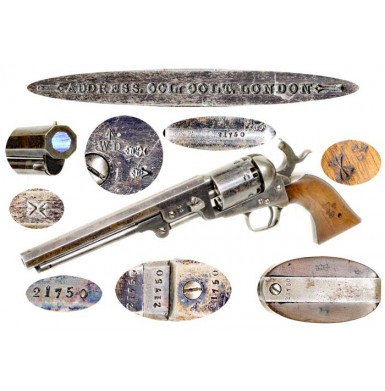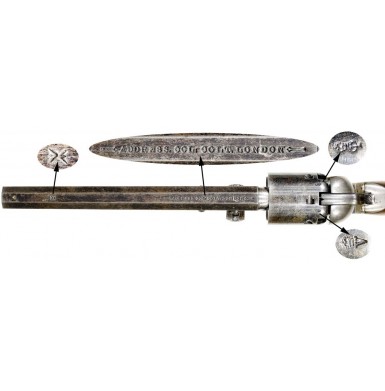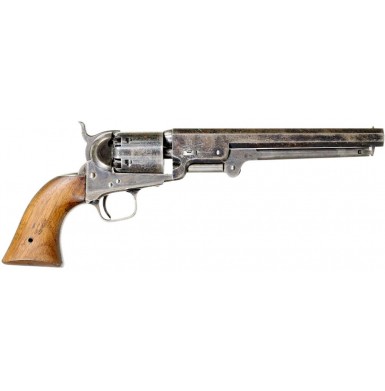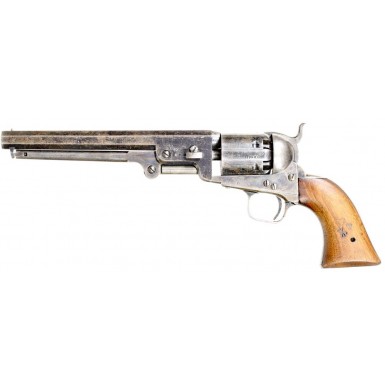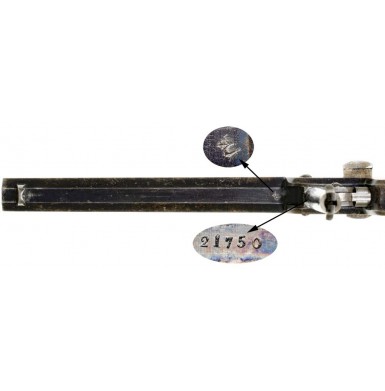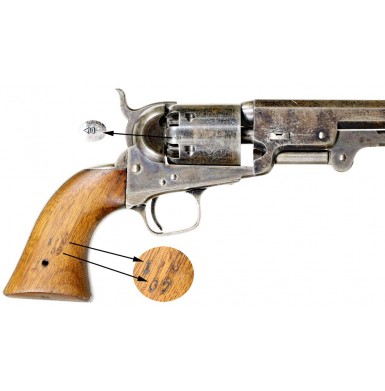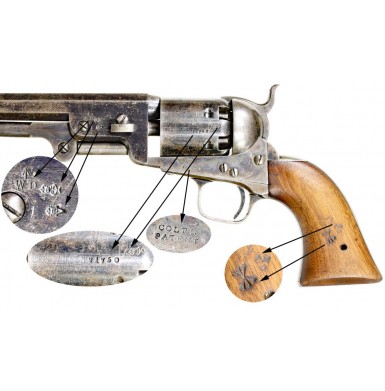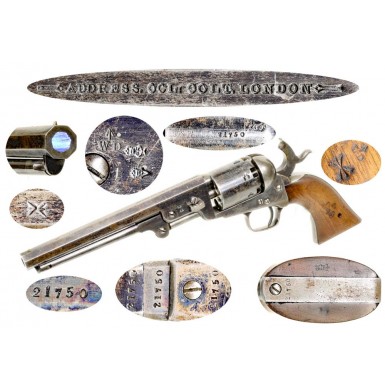British Military Colt M1851 Navy Revolver - Rare
- Product Code: FHG-2059-SOLD
- Availability: Out Of Stock
-
$1.00
The Colt Model 1851 “Navy” Revolver has typically been thought of as a distinctly American pistol, with many of the revolvers seeing service with the Union and Confederate military during the course of the American Civil War, as well as seeing significant civilian service on the frontier. However, most collectors are unaware that the Colt M1851 Revolver was the first revolver to be accepted into service and issued by the British military. Colts revolver designs were first brought to prominence in England during the great Crystal Palace Exhibition in London during 1851. Two major events that would affect the future of Colt with the British military occurred at that time. First, the Admiralty requested some sample Colt revolvers to be tested against those being manufactured by Deane, Adams & Deane under Robert Adams’ 1851 patent. Second, Samuel Colt was invited to speak at the English Institute of Civil Engineers on November 25, 1851. Colt took advantage of this opportunity to extol the virtues of the “American System of Manufacture” that he used in his Hartford facility; in other words, the use of machinery and interchangeable parts to manufacture items using an assembly line process, resulting in higher quality, more consistent items and increased output. He even noted that unskilled workers, including women and children could be used with this system of manufacture, as only a handful of skilled workmen were required to operate and oversee the machinery and unskilled laborers could assemble the parts that were created. Colt’s presentation flew in the face of the English handmade manufacturing process in which every worker was a craftsman who had gone through an appropriate (and often lengthy) apprenticeship to acquire the necessary skills to do his job. The leading revolver maker in England during that period was Robert Adams. Adams was present at the meeting and took umbrage to Colt’s statements and challenged their validity in what apparently became a fairly heated exchange between rival handgun manufacturers. In the end, Colt pointed out that Adams’ manufacturing process was slow and inefficient, and that Adams’ double action lock work design resulted in a heavy trigger pull that could only be a detriment to accurate shooting. The best Adams could do is point out that in the trials held by the Royal Navy between the Colt and Adams designs, the Colt was “not recommended.” However, as no Board of Ordnance or Admiralty report exists regarding these trials that I am aware of, it is not clear what the actual conclusion of the testing was. More than likely any failing in the Colt design was simply that it was not “British” or British made; as the Board of Ordnance had always been very protective of their own arms making industry and rarely went outside their country for small arms unless forced to by the exigencies of war. Interestingly, during the exchange Thomas Hastings (a member of the Board of Ordnance), who was privy to the trials, made a point of noting that Adams’ version of the trial results was not an official one and essentially said any negative comments should be taken with a grain of salt. Hastings then proceeded to make a number of positive comments about the Colt design. By the conclusion of the meeting it was clear that Colt’s revolver and production methods would find at least some favor in Great Britain, and Colt proceeded to set his sights on opening a London based manufactory.
With the advent of the Crimean War and the sudden need for handguns in the field, the British Ordnance Department placed orders for a total of 23,700 Colt’s “Navy” pistols. The .36 caliber revolver was a departure from British military handgun doctrine in many ways, as it was both a very small caliber (.36) when compared to the traditional British military pistols that were typically between .58 and .65 caliber, and it was a multi-shot weapon. The general acceptance of modern repeating handguns was still very much up in the air with the British military at that time, but they proceeded with the order anyway. These revolvers were delivered between March of 1854 and February of 1856, when the Crimean War ended. While many of these guns were delivered from Colt’s London production facility, additional revolvers were delivered from his US based Hartford manufactory as well. Of these revolvers, 9,600 were issued to the Royal Navy, 5,000 were issued to the army in the Crimea and 9,000 remained in store at the Tower of London as of February 1856. Period accounts indicate that the Royal Navy found the revolvers quite useful, particularly for boarding parties. In fact, after the conclusion of the Crimean conflict, the Royal Navy continued to utilize the Colt revolvers in Chinese waters during the Second Opium War that broke out in the fall of 1856. Within the British army, the use of revolvers was much more limited. The issuance of the revolvers was confined to officers and infantry sergeant majors, and in those rare cases where sufficient numbers of single shot pistols were not available for mounted troops. All Lancers were authorized pistols, as were sergeant majors of Dragoons and Hussars, as well as trumpeters. Due to shortages of appropriate arms, it was acceptable to issue the revolvers on an emergency basis if the single shot pistols were unavailable. It is worth noting that at the end of the conflict the revolvers were returned to stores and with the smaller, peace time army in the field, a return was made to single shot pistols. Only the Royal Navy used Colt revolvers would remain in service after the conclusion of the Crimean War.
The majority of the British purchased military guns were standard London production Colt M1851s. These guns featured iron backstraps, large iron rounded triggerguards, the standard Colt London address, small “severe” London style serial numbers, rounded head frame screws and “Slim Jim” grips. Some American made revolvers were delivered to complete the order, with the usual brass backstraps and triggerguards. However, all of these British military purchased Colt Navy revolvers were standard six-shot, .36 caliber revolvers with 7 ““ octagonal barrels. Other than the 23,700 Colt M1851 Navy revolvers acquired during the Crimean War period, there are no additional records regarding the purchase of Colt M1851 Navy revolvers (or any other Colt revolvers that I am aware of) by the British military. Regarding the disposition of these Colt revolvers after the war, English arms authors Chamberlain & Taylerson note: “With peace, these small-calibre Land Service revolvers were quietly abandoned to naval or Colonial needs.” The British military did acquire a small number of Adams patent revolvers during the Crimean War as well, but they were larger caliber 54-Bore (.442 caliber) and 38-Bore guns (.50 caliber), thus the authors’ comments about the Colts being “small-calibre” revolvers. It is worth noting that the War Department was obviously not impressed with the revolver at this time, as in 1856 they adopted a single shot, .577 caliber muzzle loading pistol for most mounted branches. This was no doubt due to European military doctrine that still saw the saber as the primary weapon of the cavalry, with the lance a close second. Carbines were standard arms of dragoons, but for most mounted soldiers in England and Europe, the handgun was a very secondary weapon. This orthodoxy would hamper the arming of English and Continental cavalry well into the 20th Century and the opening months of World War I. Strangely, the revolver would not be widely adopted for military service in England until more than a decade after the end of the Crimean War, at a time when change over from muzzleloading Enfield pattern arms to Snider pattern breechloading arms was taking place. The relegation of the Colt handguns to Naval and Colonial use in the post-Crimean period would no doubt explain the lack of British military marked Colt revolvers on the modern collector market, as the number was fairly small to begin with. Colonial and Royal Naval service was most certainly a death sentence to most of those handguns, due to both the service environment and potential for loss. This type of post-war service, combined with the harsh conditions experienced by the men and materiel that had served in the Crimea, are no doubt the reason that surviving examples tend to be in heavily used, and well-worn condition.
Eventually all of the British military acquired Colt Navy revolvers were all marked with the usual London commercial proof marks, as well as the royal ownership mark of a small “Broad Arrow” and WD (War Department) mark. Due to their acquisition on the open market and the speed with which the revolvers were issued, many went into the field during the Crimean War without British military markings, although I am rather sure that the strict proof laws in England required them to at least bear London proofs prior to their issuance. The British ownership marks were apparently placed on most of the guns after they were turned in at the conclusion of the war. Some of the arms were also refurbished and refinished at this time, which is why some appear from time to time with blued frames, hammers and loading levers, parts that had originally been casehardened in mottled colors.
The British Military Marked Colt Model 1851 Navy Revolver offered here is in VERY FINE condition and is a textbook example of one of these scarce pistols. The gun is a London produced Colt Navy with the serial number 21750 placing its production in early 1855. The top barrel flat is clearly marked in a single line, flanked by arrows pointing in towards the words:
“ ADDRESS. COL. COLT. LONDON “
The left side of the barrel web, just forward of the wedge, is marked with a pair of London commercial proof and view marks, consisting of a (CROWN) / GP and (CROWN) / V as well as a War Department ownership mark consisting of a small (BROAD ARROW) / WD. The cylinder is marked with the usual COLT’s PATENT No followed by the serial number, over the W.L. Ormsby engraver’s markings. The cylinder bears the standard ENGAGED 16 MAY 1843 marking along its front edge, as well as the usual Mexican War naval engagement roll scene over most of the cylinder body. The usual set of alternating London commercial proof and view marks for a London produced or retailed revolver are present on the cylinder, between each chamber. The left side of the frame is marked with the usual two-line: COLTS / PATENT and the left side of the one-piece grip bears a (BROAD ARROW) / WD mark. The right side of the grip retains the remnants of a two-line rack or issue mark that is not fully discernable, but appears to read 1” / 67. The bottom of the grip is marked with a War Department inspector mark of a (CROWN) / 15, and a (CROWN) inspection stamp is stamped on the bottom of the barrel, concealed by the loading lever. Both the left side of the grip and the top of the barrel flat, behind the front sight, show a set of “Opposed Broad Arrows”, the two arrows meeting point to point. This is the “sold out of service” mark of British military arms, applied when the items were sold off as surplus. As noted, the gun is serial number 21750 and is matching throughout. The full serial number appears on the bottom of the gripstrap, on the triggerguard, on the frame, on the barrel web, on the loading lever, on the cylinder arbor pin and on the cylinder. The partial number 750 is present on the bottom of the wedge but appears to be re-struck in a different die font, probably when the gun was returned from service to War Department stores. The wedge is a correct period wedge and is in the same condition as the balance of the gun. The grip is numbered in the backstrap cut-out in period ink. The ink is faded and dulled and difficult to read but appears to be matching with the balance of the gun.
The gun is in VERY FINE condition overall and retains much of its original finish, a very rare condition to find one of these revolvers in. The barrel retains 50%+ of the original blued finish. The bottom three flats of the octagonal barrel retain the most finish, with the upper and side flats showing some flaking and finish loss. This is especially true along the high edges and contact points that show loss from wear. The areas where the finish has worn away have an attractive smoky blue-gray patina and are shot through with flecks of original blue and some flecks of light oxidation as well. The barrel retains very sharp edges and all barrel markings remain crisp and clear. As is often the case with Colt percussion revolvers, the obverse of the barrel web shows numerous small impact marks around the wedge where it has been driven out of the revolver over the years. The bore of the revolver rates about VERY FINE as well. It remains mostly bright with some lightly scattered oxidation, minor discoloration and some pinpricking. The cylinder retains about 50%+ of its original blue as well, showing flaking, fading and loss like the barrel. It retains about 85%+ of the Mexican War naval engagement scene, which remains crisp and clear. The patent markings and the serial number on the side of the cylinder remain sharp and clear, but the Ormsby marking below is weak. The “Engaged 16 May 1843” legend on the front edge of the cylinder is very light and mostly illegible, apparently from holster wear in combination with a very light rolling of the mark. The rear of the cylinder retains all of the original stop pins, and they are very crisp condition. All of the original cones (nipples) are in place as well and are in similarly fine condition. The frame, loading lever and hammer all retain about 70%+ of their original, mottled casehardened colors. The coloration is about 50%+ vibrant with some fading and dulling due to age and some silvering around the edges. The iron gripstrap and backstrap are the only two parts of the gun that retain no finish to speak of. They are mostly smooth, with only some lightly scattered pinpricking and a pewter gray patina. The balance of the gun is quite smooth as well and is essentially free of any pitting, with only some oxidized roughness and pinpricking in the cone recesses of the rear of the cylinder and some light etching on the cylinder face and some similar caustic erosion on the muzzle. The revolver retains its original brass cone shaped front sight and all of the frame screws appear to be original as well. The screws are the correct, dome head screws found on London produced Colt Navy revolvers and most retain at least some of their fire blued finish, although most have faded and dulled to some extent. The screw heads are all in very nice condition, with only one of the backstrap screws showing any significant slot wear. The pistol is mechanically EXCELLENT and the action functions perfectly with fine timing, indexing and tight lockup. The one-piece walnut grip is in about VERY GOOD condition. The grip has been lightly sanded and this is the only real defect or detraction that can truly be noted on the gun. The sanding has left the backstrap slightly proud of the wood and has left the grip markings lightly smeared. In typical British military fashion, a lanyard hole has been drilled through the center of the grip, a feature often encountered on English military revolvers of the mid-19th century. The grip shows some light handling marks and a minor sliver is missing from the bottom inner edge of the right side, where it meets the bottom of the grip frame. Otherwise, the grip remains solid and complete and is free any and breaks, cracks or repairs.
Overall this is a really outstanding example of an extremely scarce British military accepted Colt revolver from the Crimean War period. These are historic guns as the first British military revolvers to see purchase and issue. Many of these revolvers went on to see additional Royal Navy service and service around the British Empire in various colonial outposts during the third quarter of the 19th century, after the Crimean War. Very few were acquired, very few survive, and when they do appear on the collector market they are nearly always in fairly rough and very well used condition. This one is a real gem. The gun is 100% complete and correct, with the possible exception of the wedge, which matches the condition of the gun perfectly and was mostly likely replaced during the period of service. This is really an exceptional example of a scarce gun that belongs in an advanced Crimean War or British military percussion revolver collection, or in an equally advanced Colt M1851 Navy collection. These guns are significantly rarer than US Marital Colt Navy revolvers, but a US Martial Navy in this condition would be priced at nearly 5-figures, or possibly above that point! I am absolutely positive you will be exceptionally pleased to add this very scarce Crimean War British Military Colt M1851 Navy Revolver to your collection. I know that I am extremely proud to offer it for sale.
SOLD
